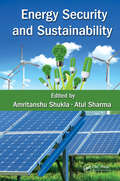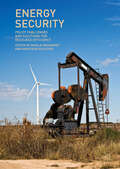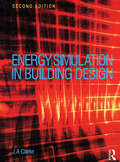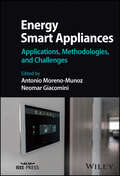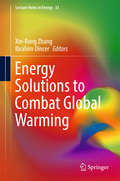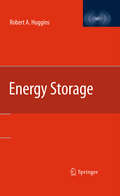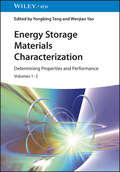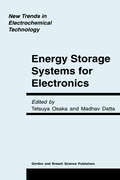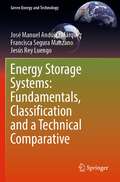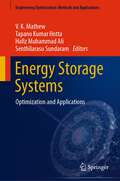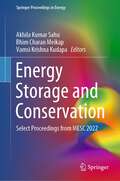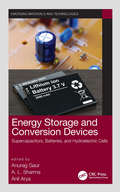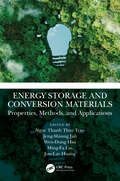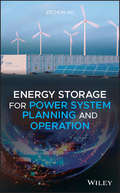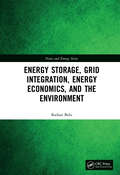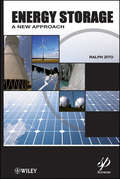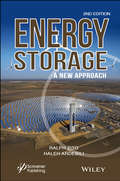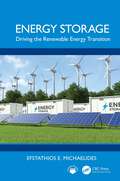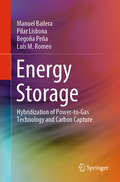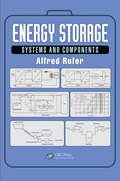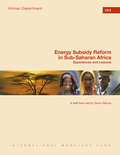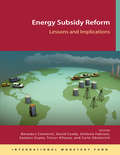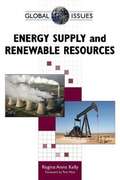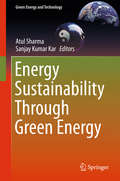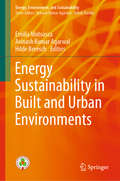- Table View
- List View
Energy Security and Sustainability
by Atul Sharma Amritanshu ShuklaThere has been ever increasing interest in understanding the various aspects of available resources and production, in terms of need and supply, conservation and environmental impacts and so on. From the current energy scenario, it is very clear that there are serious challenges related in achieving energy sustainability and security worldwide. The aim of this book is to present an overview of progress made towards energy sustainability addressing concerns regarding carbon emission and clean energy resources. Keeping this in mind, the book has chapters on all major energy sources which are being utilized at present, along with those having potential prospects for future.
Energy Security: Policy Challenges and Solutions for Resource Efficiency
by Nikolai Mouraviev Anastasia KoulouriThis book discusses energy policy within the framework of the expansion of renewable energy sources (RES) and increasing resource use efficiency. In this book, the term ‘resource efficiency’ is defined as deriving the most value from resource inputs related to energy production, while incorporating energy efficiency. The authors highlight the drivers, policy approaches, governance issues and management problems related to the reduction of dependency on fossil fuels by focusing on RES and resource efficiency. Mouraviev and Koulori argue that enhancing energy security requires a new approach, integrating two core components: the emphasis on increasing energy production from renewable sources and resource use efficiency, which forms a contrast to the traditional understanding of energy security as security of supply. Blending theory with practice using several case studies, this original book provides a novel conceptualisation of energy security that will be of interest and value to practitioners and policy makers as well as scholars and researchers.
Energy Simulation in Building Design
by Joseph ClarkeSince the appearance of the first edition of 'Energy Simulation in Building Design', the use of computer-based appraisal tools to solve energy design problems within buildings has grown rapidly. A leading figure in this field, Professor Joseph Clarke has updated his book throughout to reflect these latest developments. The book now includes material on combined thermal/lighting and CFD simulation, advanced glazings, indoor air quality and photovoltaic components. This thorough revision means that the book remains the key text on simulation for architects, building engineering consultants and students of building engineering and environmental design of buildings. The book's purpose is to help architects, mechanical & environmental engineers and energy & facility managers to understand and apply the emerging computer methods for options appraisal at the individual building, estate, city, region and national levels. This is achieved by interspersing theoretical derivations relating to simulation within an evolving description of the built environment as a complex system. The premise is that the effective application of any simulation tool requires a thorough understanding of the domain it addresses.
Energy Smart Appliances: Applications, Methodologies, and Challenges
by Antonio Moreno-Munoz Neomar GiacominiEnergy Smart Appliances Enables designers and manufacturers to manage real-world energy performance and expectations by covering a range of potential scenarios and challenges Energy Smart Appliances provides utilities and appliance manufacturers, and designers with new approaches to better understand real-world performance, assess actual energy benefits, and tailor each technology to the needs of their customers. With contributions from a fully international group of experts, including heads of prestigious research organizations and leading universities, and innovation managers of the main appliance manufacturers, Energy Smart Appliances includes discussion on: Enabling technologies for energy smart appliances, covering IoT devices and technology and active energy efficiency measures in residential environments Smart home and appliances, answering questions like ‘Where are we heading in terms of the overall smart homes’ future?’ and ‘What’s the energy impact from smart home devices?’ Demand-side management and demand response, covering overall system/ appliances readiness and ideal energy management scenario to drive demand response Energy smart appliances’ best practices and success stories, including refrigerators, washers, dryers, and more With practical coverage of a wide range of potential scenarios and existing and future challenges, Energy Smart Appliances is an essential learning resource for electrical engineering professionals, equipment manufacturers, and designers, along with postgraduate electrical engineering students and researchers in related fields and programs of study.
Energy Solutions to Combat Global Warming
by Ibrahim Dincer Xinrong ZhangThis book gathers an in-depth collection of 45 selected papers presented at the Global Conference on Global Warming 2014 in Beijing, China, covering a broad variety of topics from the main principles of thermodynamics and their role in design, analysis, and the improvements in performance of energy systems to the potential impact of global warming on human health and wellbeing. Given energy production's role in contributing to global warming and climate change, this work provides solutions to global warming from the point of view of energy. Incorporating multi-disciplinary expertise and approaches, it provides a platform for the analysis of new developments in the area of global warming and climate change, as well as potential energy solutions including renewable energy, energy efficiency, energy storage, hydrogen production, CO2 capture and environmental impact assessment. The research and analysis presented herein will benefit international scientists, researchers, engineers, policymakers and all others with an interest in global warming and its potential solutions.
Energy Storage
by Robert HugginsThis is a comprehensive overview of energy storage concepts, methodologies and applications. Students will find chapters exploring the underlying energy storage fundamentals under various conditions, such as organic fuels, phase transitions and heat capacity, in addition to reversible chemical reactions. Important energy storage types such as mechanical, hydrogen and electromagnetic energy storage are discussed in a pedagogical language and structure accessible to students and researchers alike. Valuable coverage of various types of batteries are included, such as metal hydride / "nickel", lithium, lead-acid and primary batteries, in addition to a variety of current applications.
Energy Storage Materials Characterization: Determining Properties and Performance
by Yongbing Tang Wenjiao YaoComprehensive summary of the properties and performance of experimental analytical techniques for a wide range of electrochemical energy storage materials Energy Storage Materials Characterization summarizes the basic methods used to determine the properties and performance of energy storage materials and details a wide range of techniques used in electrochemical testing, including X-ray, neutron, optical, microwave, electron, and scanning probe techniques. Representative examples of each technique are presented to illustrate their powerful capabilities and offer a general strategy for future development of the original techniques. Preceding the main text, a helpful introduction covers topics including the overall energy consumption structure of the modern world, various existing forms of energy and electrochemical energy storage, known problems with energy storage materials such as lithium-ion batteries, and specifics of electrochemical impedance spectroscopy (EIS). Written by two highly qualified academics with significant research experience in the field, Energy Storage Materials Characterization includes information such as: Photoemission spectroscopy, X-ray pair distribution function to investigate battery systems, and cryo-electron microscopyX-ray diffraction, absorption spectroscopy, fluorescence and tomography microscopy, and neutron scattering, depth profile, and imagingUV-Vis spectroscopy for energy storage and related materials, Raman spectroscopy, Fourier transform infrared spectroscopy, and optical microscopyStructural and chemical characterization of alkali-ion battery materials using electron energy-loss spectroscopy coupled with transmission electron microscopy Energy Storage Materials Characterization is an essential up-to-date reference on the subject for chemists and materials scientists involved in research related to improving electrochemical energy storage systems for superior battery performance.
Energy Storage Systems in Electronics (New Trends in Electrochemical Technology)
by Madhav Datta Tetsuya OsakaThis volume illustrates the technological advances made in recent years in the development of battery and other energy storage systems. Discussions of present and near future battery technologies are included as well as emerging energy technologies that have the potential to impact on the portable electronics industry in the long term. This text pr
Energy Storage Systems: Fundamentals, Classification and a Technical Comparative (Green Energy and Technology)
by José Manuel Andújar Márquez Francisca Segura Manzano Jesús Rey LuengoThis book examines different energy storage technologies, empowering the reader to make informed decisions on which system is best suited for their specific needs. Decarbonization is a crucial step towards a sustainable future, and renewable energy plays a vital role in making this transition possible. However, the intermittency of some sources such as wind and solar energy requires the use of energy storage systems. The book contains a detailed study of the fundamental principles of energy storage operation, a mathematical model for real-time state-of-charge analysis, and a technical analysis of the latest research trends, providing a comprehensive guide to energy storage systems. From battery storage systems to hydrogen storage systems, this book provides the tools to effectively manage energy and ensure that excess energy is utilized during times of deficit and signposts the likely future development and lines of research enquiry for each technology discussed. The book is of interest to researchers and professionals in energy, and engineers interested in the transition to more sustainable energy systems.
Energy Storage Systems: Optimization and Applications (Engineering Optimization: Methods and Applications)
by Hafiz Muhammad Ali Tapano Kumar Hotta V. K. Mathew Senthilarasu SundaramThis book discusses generalized applications of energy storage systems using experimental, numerical, analytical, and optimization approaches. The book includes novel and hybrid optimization techniques developed for energy storage systems. It provides a range of applications of energy storage systems on a single platform. The book broadly covers—thermal management of electronic components in portable electronic devices; modeling and optimization aspects of energy storage systems; management of power generation systems involving renewable energy; testing, evaluation, and life cycle assessment of energy storage systems, etc. This book will serve as a reference resource for researchers and practitioners in academia and industry.
Energy Storage and Conservation: Select Proceedings from MESC 2022 (Springer Proceedings in Energy)
by Bhim Charan Meikap Akhila Kumar Sahu Vamsi Krishna KudapaThis volume comprises the select proceedings of the International Conference on Materials for Energy Storage and Conservation (MESC 2022). It aims to provide a comprehensive spectrum picture of the state-of-the-art research and development in diverse areas such as energy conservation, chemical energy storage, electrical and electromagnetic energy storage, energy management, biological energy storage, nanotechnology for renewable energy, solar cell materials, thermal energy storage, energy storage risk analysis, environment and health effects of energy efficiency, among others. This volume will be of interest to researchers, academicians, professionals, policymakers, scientists, and members of the industry working in the field of energy storage and conservation.
Energy Storage and Conversion Devices: Supercapacitors, Batteries, and Hydroelectric Cells (Emerging Materials and Technologies)
by Anurag GaurThis book presents a state-of-the-art overview of the research and development in designing electrode and electrolyte materials for Li-ion batteries and supercapacitors. Further, green energy production via the water splitting approach by the hydroelectric cell is also explored. Features include: • Provides details on the latest trends in design and optimization of electrode and electrolyte materials with key focus on enhancement of energy storage and conversion device performance • Focuses on existing nanostructured electrodes and polymer electrolytes for device fabrication, as well as new promising research routes toward the development of new materials for improving device performance • Features a dedicated chapter that explores electricity generation by dissociating water through hydroelectric cells, which are a nontoxic and green source of energy production • Describes challenges and offers a vision for next-generation devices This book is beneficial for advanced students and professionals working in energy storage across the disciplines of physics, materials science, chemistry, and chemical engineering. It is also a valuable reference for manufacturers of electrode/electrolyte materials for energy storage devices and hydroelectric cells.
Energy Storage and Conversion Materials: Properties, Methods, and Applications
by Ming-Fa Lin Wen-Dung Hsu Jow-Lay Huang Jeng-Shiung Jan Tran, Ngoc Thanh ThuyThis book explores the fundamental properties of a wide range of energy storage and conversion materials, covering mainstream theoretical and experimental studies and their applications in green energy. It presents a thorough investigation of diverse physical, chemical, and material properties of rechargeable batteries, supercapacitors, solar cells, and fuel cells, covering the development of theoretical simulations, machine learning, high-resolution experimental measurements, and excellent device performance. Covers potential energy storage (rechargeable batteries and supercapacitors) and energy conversion (solar cells and fuel cells) materials Develops theoretical predictions and experimental observations under a unified quasi-particle framework Illustrates up-to-date calculation results and experimental measurements Describes successful synthesis, fabrication, and measurements, as well as potential applications and near-future challenges Promoting a deep understanding of basic science, application engineering, and commercial products, this work is appropriate for senior graduate students and researchers in materials, chemical, and energy engineering and related disciplines.
Energy Storage for Power System Planning and Operation
by Zechun HuAn authoritative guide to large-scale energy storage technologies and applications for power system planning and operation To reduce the dependence on fossil energy, renewable energy generation (represented by wind power and photovoltaic power generation) is a growing field worldwide. Energy Storage for Power System Planning and Operation offers an authoritative introduction to the rapidly evolving field of energy storage systems. Written by a noted expert on the topic, the book outlines a valuable framework for understanding the existing and most recent advances in technologies for integrating energy storage applications with power systems. Filled with full-color illustrations, the book reviews the state-of-the-art of energy storage systems and includes illustrative system models and simulations. The author explores the various techniques that can be employed for energy storage that is compatible with renewable energy generation. Designed as a practical resource, the book examines in detail the aspects of system optimization, planning, and dispatch. This important book, • Provides an introduction to the systematically different energy storage techniques with deployment potential in power systems • Models various energy storage systems for mathematical formulation and simulations • Contains a review of the techniques for integrating and operating energy storage with renewable energy generation • Analyses how to optimize power systems with energy storage, at both the transmission and distribution system levels • Shows how to optimize planning, siting, and sizing of energy storage for a range of purposes Written for power system engineers and researchers, Energy Storage for Power System Planning and Operation introduces the application of large-scale energy storage for the optimal operation and planning of power systems.
Energy Storage, Grid Integration, Energy Economics, and the Environment (Nano and Energy)
by Radian BeluThe book covers energy storage systems, bioenergy and hydrogen economy, grid integration of renewable energy systems, distributed generation, economic analysis, and environmental impacts of renewable energy systems. The overall approaches are interdisciplinary and comprehensive, covering economic, environmental, and grid integration issues as well as the physical and engineering aspects. Core issues discussed include mechanical, electrical, and thermal energy storage systems, batteries, fuel cells, biomass and biofuels, hydrogen economy, distributed generation, a brief presentation of microgrids, and in-depth discussions of economic analysis and methods of renewable energy systems, environmental impacts, life-cycle analysis, and energy conservation issues. With several solved examples, holistic material presentation, in-depth subject matter discussions and self-content material presentation, this textbook will appeal strongly to students and professional and nonprofessional readers who wish to understand this fascinating subject. Readers are encouraged to solve the problems and questions, which are useful ways to understand and apply the concepts and the topics included.
Energy Storage: A New Approach (Wiley-Scrivener #26)
by Ralph ZitoEnergy Storage: A New Approach presents practical solutions to the problem of energy storage on a massive scale. This revolutionary book describes technologies that include basic chemical concepts that engineers have been practicing for years, but presents new material that could transform the energy industry. Regardless where power is generated from—oil, natural gas, coal, solar, wind, or any of the other emerging sources— energy storage is something that the industry MUST learn and practice. With the world energy demand increasing, mostly due to industrial growth in China and India, and with the West becoming increasingly more interested in fuel efficiency and “green” endeavors, energy storage is potentially a key technology in our energy future.
Energy Storage: Driving the Renewable Energy Transition
by Efstathios E. MichaelidesEnergy Storage: Driving the Renewable Energy Transition provides a thorough and holistic understanding of the operation and state of technology of all the energy storage options. It encompasses all the methods for energy storage, the engineering systems utilized, and the relevant applications from the small device level to the electricity grid level.Using the basis of thermodynamics, the book explains the operation and features of all the available energy storage methods that may be used for the transition to renewable energy. It describes the several types of energy storage options available, their advantages and disadvantages, and their practical applications. The book includes a large number of numerical examples to build a deeper understanding of the operation of actual energy storage systems and enable the reader to perform quantitative analyses and feasibility studies.The book is intended for undergraduate and graduate students taking courses in Energy Conversion, Sustainability, Renewables and Energy Storage, and Energy Transition.End-of-chapter problems, exercises, and solved examples are included. A Solutions Manual and Figure Slides are available to adopting instructors as online Support Material.
Energy Storage: Hybridization of Power-to-Gas Technology and Carbon Capture (Springerbriefs In Energy Ser.)
by Manuel Bailera Pilar Lisbona Begoña Peña Luis M. RomeoThis book presents a detailed analysis of Power-to-Gas, a promising energy storage technology. It discusses the main mechanisms involved, and presents two Power-to-Gas and carbon capture hybridizations. The book begins by providing an introduction to energy storage technologies. It then reviews a number of Power-to-Gas projects now in progress, highlighting the current barriers to commercializing the technology. Moreover, the book presents two novel Power-to-Gas hybridizations, which improve the technology’s applicability in terms of efficiency, utilization of resources and profitability. Given its scope, the book will be of interest to graduate students, researchers and practitioners in the fields of engineering and energy.
Energy Storage: Systems and Components
by Alfred RuferThis book will provide the technical community with an overview of the development of new solutions and products that address key topics, including electric/hybrid vehicles, ultrafast battery charging, smart grids, renewable energy (e.g., solar and wind), peak shaving, and reduction of energy consumption. The needs for storage discussed are within the context of changes between the centralized power generation of today and the distributed utility of tomorrow, including the integration of renewable energy sources. Throughout the book, methods for quantitative and qualitative comparison of energy storage means are presented through their energy capacity as well as through their power capability for different applications. The definitions and symbols for energy density and power density are given and relate to the volume and weight of a given system or component. A relatively underdeveloped concept that is crucial to this text is known as the theory of Ragone plots. This theory makes possible the evaluation of the real amount of energy that can possibly release out of a given system, with respect to the level of power dependency chosen for the discharge process. From systems using electrochemical transformations, to classical battery energy storage elements and so-called flow batteries, to fuel cells and hydrogen storage, this book further investigates storage systems based on physical principles (e.g., gravitational potential forces, air compression, and rotational kinetic energy). This text also examines purely electrical systems such as superconductive magnets and capacitors. Another subject of analysis is the presentation of power electronic circuits and architectures that are needed for continuously controllable power flow to and from different storage means. For all systems described, the elementary principles of operation are given as well as the relationships for the quantified storage of energy. Finally, Energy Storage: Systems and Components contains multiple international case studies and a rich set of exercises that serve both students and practicing engineers.
Energy Subsidy Reform in Sub-Saharan Africa: Experiences and Lessons
by Trevor AlleyneA report from the International Monetary Fund.
Energy Subsidy Reform: Lessons and Implications
by Sanjeev Gupta Stefania Fabrizio Benedict Clements David Coady Trevor Alleyne Carlo SdralevichEnergy subsidies have wide-ranging economic consequences. Although they are aimed at protecting consumers, subsidies aggravate fiscal imbalances, crowd out priority public spending, and depress private investment, including in the energy sector. Subsidies also distort resource allocation by encouraging excessive energy consumption, artificially promoting capital-intensive industries, reducing incentives for investment in renewable energy, and accelerating the depletion of natural resources. Most subsidy benefits are captured by higher-income households, reinforcing inequality. Even future generations are affected through the damaging effects of increased energy consumption on global warming. This book provides (1) the most comprehensive estimates of energy subsidies currently available for 176 countries and (2) an analysis of 'how to do' energy subsidy reform, drawing on insights from 22 country case studies undertaken by the IMF staff and analyses carried out by other institutions.
Energy Supply and Renewable Resources
by Regina Anne KellyThis reference is designed to be a first-stop resource for high school and undergraduate students. It surveys current energy production and consumption trends and controversies, and draws parallels between the energy challenges faced by the US and several other nations. As with other volumes in the series, the book contains three sections, with an introduction to national and global issues followed by excerpts and full texts of US and international primary source documents. The third section provides research tools, including brief biographies, statistical data, an annotated bibliography, and detailed guidance on researching global energy issues online and in libraries. A chronology and a glossary are also included. Kelly has written on energy for scientific and trade journals. Annotation ©2007 Book News, Inc., Portland, OR (booknews.com)
Energy Sustainability Through Green Energy
by Atul Sharma Sanjay Kumar KarThis book shares the latest developments and advances in materials and processes involved in the energy generation, transmission, distribution and storage. Chapters are written by researchers in the energy and materials field. Topics include, but are not limited to, energy from biomass, bio-gas and bio-fuels; solar, wind, geothermal, hydro power, wave energy; energy-transmission, distribution and stora≥ energy-efficient lighting buildings; energy sustainability; hydrogen and fuel cells; energy policy for new and renewable energy technologies and education for sustainable energy development.
Energy Sustainability in Built and Urban Environments (Energy, Environment, and Sustainability)
by Avinash Kumar Agarwal Emilia Motoasca Hilde BreeschThis book covers different aspects of energy sustainability in residential buildings and neighborhoods, starting from the construction and design aspects, and moving on to HVAC systems and lighting, and the applications, harvesting, use and storage of renewable energy. The volume focuses on smart and sustainable use of energy, discussing both the technological advancements and the economic, social and environmental impacts. Novel approaches to recycling of waste and materials in the context of residential buildings are also presented. This volume will be of interest to researchers and policy makers working in the fields of renewable energy, sustainable design and city planning.
